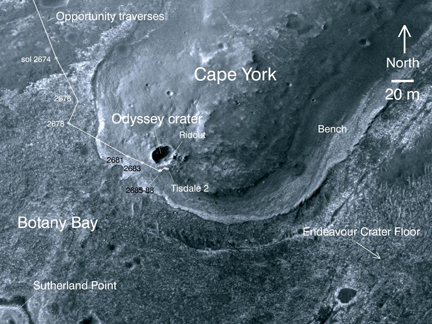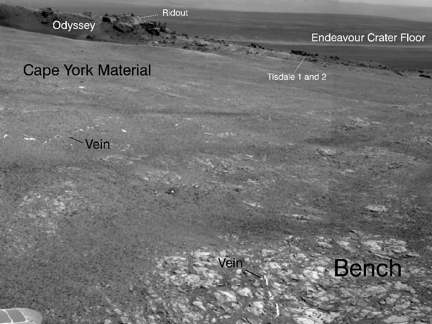Opportunity rover begins 'new' mission at Endeavour crater
09/01/2011 07:54 PM Filed in: Space News | Planetary Exploration
By WILLIAM HARWOOD
CBS News
Seven-and-a-half years after bouncing to a touchdown on Mars, NASA's aging Opportunity rover is beginning what excited scientists say is a new mission exploring a 13.7-mile-wide crater that may hold unexpected clues about the ancient environment of the red planet.
"This has the potential to be the most revealing destination ever explored by Opportunity," said Dave Lavery, program executive for the Mars Exploration Rovers at NASA headquarters. "This region is substantially different than anything we've seen before. We're looking at this next phase of Opportunity's exploration as a whole new mission, entering an area that is significantly different in the geologic context than anything we've seen with the rovers."
Since landing on Mars, Opportunity has roved nearly 21 miles across Meridiani Planum to reach Endeavour Crater, a heavily eroded, partially buried impact basin with disconnected rim segments and ancient rocks that may offer new insights into the planet's evolution.
"The region around Endeavour has the potential to reveal new science results and new understanding about both the ancient and current environment of Mars and some of the early formative processes of the planet," Lavery said. "Opportunity may soon be able to examine clay minerals and rock types that formed in low-acid, wet conditions, which may tell us more about a potentially habitable environment that appears to have been very different from the plains the rover has been driving across."
Opportunity and a twin rover, Spirit, were designed to operate for three months and to rove less than one mile. They landed on opposite sides of Mars in January 2004 and promptly exceeded everyone's wildest expectations, operating year after year in the harsh martian environment. Spirit, stuck in loose soil and unable to keep its fixed solar panels properly oriented, finally fell silent in March 2010.
But Opportunity is still operating, although it's clearly showing the signs of old age. Long-time rover watchers are reminded of an exchange in "Raiders of the Lost Ark" when Karen Allen's character, Marion, told Harrison Ford's Indiana Jones, "you're not the man I knew 10 years ago," to which Jones responded: "It's not the years, honey, it's the mileage."
In Opportunity's case, it's both.
"We're no longer driving a hot new sports car," Lavery said. "We're now driving a 1965 Mustang that hasn't been restored. It's a classic and it's served us well, but we have to drive it gently and treat her systems with care. We periodically drive backwards toward our goal to evenly distribute the lubricants within the wheel actuators. We have aging isotope sources in some of the science instruments that now take many hours to make accurate measurements instead of just minutes as they once did.
"Opportunity's robotic arm always points out ahead of the rover, held in place by a stuck actuator since 2008. We have these great little radioisotope heater units that have been keeping the electronics warm during frigid martian nights, which are slowly decaying and are not quite as efficient as they were when we landed. This is an entirely different software load than what was in place when Opportunity landed, which gives her more autonomy and greater ability to navigate on Mars."
All in all, Opportunity "is significantly different than the one we landed seven-and-a-half years ago," Lavery said. "This rover is one we're using carefully. We're treating every extra day of exploration as an unexpected gift in full recognition that Opportunity's mission could end at any time."
Said rover Project Manager John Callas: "All in all, we have a very senior rover that's showing her age, she has some arthritis and some other issues but generally, she's in good health, she's sleeping well at night, her cholesterol levels are excellent and so we look forward to productive scientific exploration for the period ahead."
Opportunity arrived at Endeavour Crater three weeks ago. Crossing from the sandy sedimentary rocks of Meridiani Planum into an area with much older rocks unearthed by the Endeavour impact, Opportunity surprised scientists by discovering high levels of zinc in the first rock it examined, a block dubbed Tisdale 2 that was blasted out of a small crater along Endeavour's rim in a region known as Cape York.
Steve Squyres, the principal investigator of the rover project, said Tisdale 2 is "not like anything we've ever seen before. So this is a new kind of rock."
"The other big take-away message, and this is to me the most interesting thing about Tisdale, is that this rock has a huge amount of zinc in it, way more zinc than we have ever seen in any martian rock," he said. "And we are puzzling, we are thinking very hard over what that means."
On Earth, zinc is easily transported through rocks by hot water.
"When you find rocks on Earth that are rich in zinc, they typically form in a place where had some kind of hydrothermal activity going on, in other words, you have water that gets heated up and it flows through the rocks and it can dissolve out and it can get redeposited in various places," Squyres said. "So this is a clue, not definitive proof yet, but this is a clue that we may be dealing with a hydrothermal system here, we may be dealing with a situation where water has percolated or flowed or somehow moved through these rocks, maybe as vapor, maybe as liquid, don't know yet.
"But it has enhanced the zinc concentration in this rock to levels far in excess of anything we've ever seen on Mars before. So that's the beginning of what we expect is going to be a long and very interesting story about these rocks."
CBS News
Seven-and-a-half years after bouncing to a touchdown on Mars, NASA's aging Opportunity rover is beginning what excited scientists say is a new mission exploring a 13.7-mile-wide crater that may hold unexpected clues about the ancient environment of the red planet.
"This has the potential to be the most revealing destination ever explored by Opportunity," said Dave Lavery, program executive for the Mars Exploration Rovers at NASA headquarters. "This region is substantially different than anything we've seen before. We're looking at this next phase of Opportunity's exploration as a whole new mission, entering an area that is significantly different in the geologic context than anything we've seen with the rovers."
 |
| NASA's Opportunity rover is exploring the Cape York area of Endeavour Crater. (NASA) |
 |
| A closeup of the Cape York rim segment of Endeavour Crater with the Opportunity rover's path shown. (NASA) |
Opportunity and a twin rover, Spirit, were designed to operate for three months and to rove less than one mile. They landed on opposite sides of Mars in January 2004 and promptly exceeded everyone's wildest expectations, operating year after year in the harsh martian environment. Spirit, stuck in loose soil and unable to keep its fixed solar panels properly oriented, finally fell silent in March 2010.
 |
| Opportunity's view into Endeavour crater. (NASA) |
In Opportunity's case, it's both.
"We're no longer driving a hot new sports car," Lavery said. "We're now driving a 1965 Mustang that hasn't been restored. It's a classic and it's served us well, but we have to drive it gently and treat her systems with care. We periodically drive backwards toward our goal to evenly distribute the lubricants within the wheel actuators. We have aging isotope sources in some of the science instruments that now take many hours to make accurate measurements instead of just minutes as they once did.
"Opportunity's robotic arm always points out ahead of the rover, held in place by a stuck actuator since 2008. We have these great little radioisotope heater units that have been keeping the electronics warm during frigid martian nights, which are slowly decaying and are not quite as efficient as they were when we landed. This is an entirely different software load than what was in place when Opportunity landed, which gives her more autonomy and greater ability to navigate on Mars."
All in all, Opportunity "is significantly different than the one we landed seven-and-a-half years ago," Lavery said. "This rover is one we're using carefully. We're treating every extra day of exploration as an unexpected gift in full recognition that Opportunity's mission could end at any time."
Said rover Project Manager John Callas: "All in all, we have a very senior rover that's showing her age, she has some arthritis and some other issues but generally, she's in good health, she's sleeping well at night, her cholesterol levels are excellent and so we look forward to productive scientific exploration for the period ahead."
Opportunity arrived at Endeavour Crater three weeks ago. Crossing from the sandy sedimentary rocks of Meridiani Planum into an area with much older rocks unearthed by the Endeavour impact, Opportunity surprised scientists by discovering high levels of zinc in the first rock it examined, a block dubbed Tisdale 2 that was blasted out of a small crater along Endeavour's rim in a region known as Cape York.
Steve Squyres, the principal investigator of the rover project, said Tisdale 2 is "not like anything we've ever seen before. So this is a new kind of rock."
"The other big take-away message, and this is to me the most interesting thing about Tisdale, is that this rock has a huge amount of zinc in it, way more zinc than we have ever seen in any martian rock," he said. "And we are puzzling, we are thinking very hard over what that means."
On Earth, zinc is easily transported through rocks by hot water.
"When you find rocks on Earth that are rich in zinc, they typically form in a place where had some kind of hydrothermal activity going on, in other words, you have water that gets heated up and it flows through the rocks and it can dissolve out and it can get redeposited in various places," Squyres said. "So this is a clue, not definitive proof yet, but this is a clue that we may be dealing with a hydrothermal system here, we may be dealing with a situation where water has percolated or flowed or somehow moved through these rocks, maybe as vapor, maybe as liquid, don't know yet.
"But it has enhanced the zinc concentration in this rock to levels far in excess of anything we've ever seen on Mars before. So that's the beginning of what we expect is going to be a long and very interesting story about these rocks."